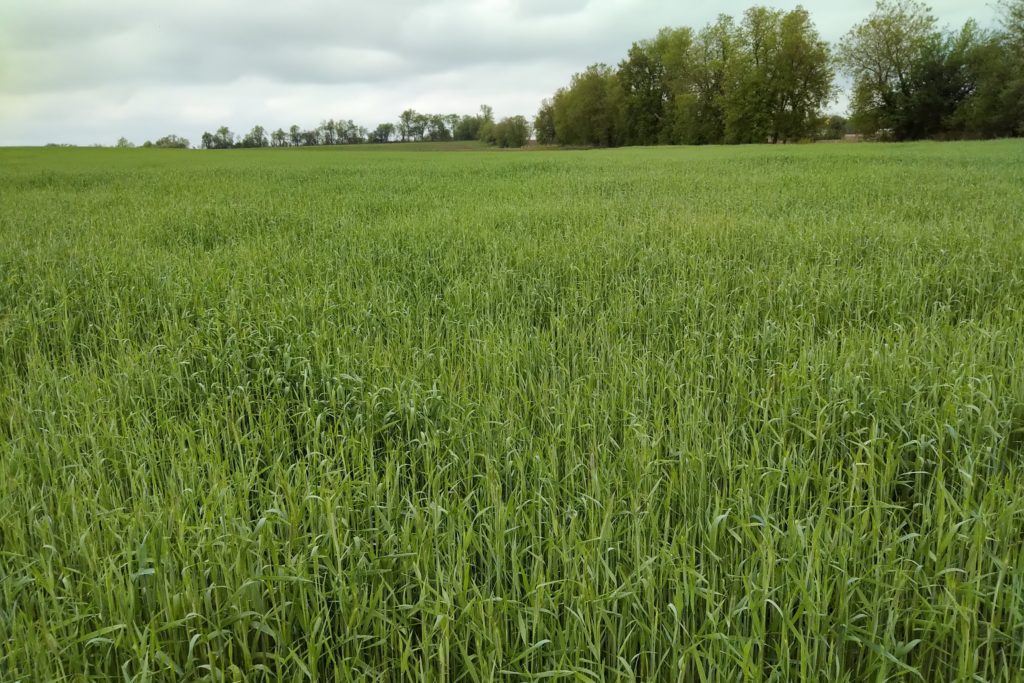Cereals, soybeans, and silage corn are all being harvested, or will be soon! That bare ground provides an opportunity to boost forage inventories by double cropping with a winter cereal, while getting all the benefits of a cover crop in the rotation.
Why use winter cereals as forage?
- It’s a cover crop that makes money the year it is grown. If you have livestock, forage generates the meat or milk that leads to a paycheque. If you don’t have livestock, ask some neighbours to see if someone is interested in buying your standing cereal crop. Most cover crop benefits come from the roots, not the top growth, so there’s an opportunity to sell the forage without compromising on soil health.
- They have higher yield potential than spring cereals. Provided there is enough forage on hand to feed livestock all winter, this strategy can produce more forage per acre than planting spring cereals in late summer or early fall. Research by Dr. Bill Deen and colleagues shows that oats will yield around 2.3 tonnes of dry matter (DM) per hectare (ha), while fall rye can yield 3.0 tonnes DM/ha.
- Winter cereals are ready for forage harvest before the next crop is planted. The time when forage supplies are tightest is when winter cereals are ready to cut. This provides a home-grown boost to feed inventories when hay prices are strongest.
- They are ready to be grazed before perennial pastures. If the infrastructure is available, grazing winter cereals in the early spring provides a longer rest for perennial pastures. Conventional wisdom says turning livestock out to pasture a day too early in the spring costs three days of grazing in the fall. Maximize your pasture’s yield potential by grazing a winter cereal until the perennial grasses have 3-4 fully developed leaves, then switch the livestock over.
Fall rye is the most commonly used winter cereal for forage in Ontario. It is the most winter hardy and the earliest maturing species. Fall rye can be sown after silage corn harvest on well-drained soils. Winter wheat is more palatable than rye, but by the time it reaches flag-leaf to early boot stage, crop options to follow it are limited. Triticale is a hybrid of rye and wheat. It is ready to harvest 7-14 days later than rye. Seed can be difficult to source in Ontario, so it is often the most expensive winter cereal. Winter barley seems to consistently winter kill in southern Ontario and is therefore may not be a good choice for a forage double crop.
How to get the most out of forage winter cereals:
- Fertilize the crop. Unlike a cover crop, forages need to be fed to reach their potential. Incorporating manure Ahead of planting a winter cereal is a great way to use manure nutrients. Where no manure is available, apply P and K as a starter as per the soil test, and 55 kg N/ha (50 lbs/acre) in the spring at green-up.
- Use a forage seeding rate. Cover crop recommendations are often too light to produce good forage crops. Winter cereals should be planted at 110 kg/ha (100 lbs/acre). Seed at 3-4 cm (1.25-1.5 in.) depth to reduce heaving.
- Plant them early. Tom Kilcer’s research in New York state suggests that there is a 20-30% increase in forage yield if fall rye and winter triticale are planted 10-14 days before the optimum winter wheat planting date. This gives the crop plenty of time to tiller in the fall. More tillers generate more stems, and provide a higher forage yield overall. If double-cropping winter cereals for forage is going to be a staple in the crop rotation, producers should consider a shorter season silage corn or soybean to enable timely planting of the cereal.
- Harvest at flag-leaf to boot stage for maximum feed value. Digestible fibre and crude protein contents are highest before the crop starts to head out. Nutritional quality declines quickly once the heads emerge, through triticale seems to retain quality a little better than rye. This early harvest window enables timely planting of the following crop.
In situations where there is enough forage available for winter feeding, winter cereals can be a great way to boost forage inventories in the spring. They yield higher than fall-planted spring cereals, are ready to harvest earlier in the spring than any other forage and provide all the benefits of a cover crop.
Sources:
Brown, C. (ed.) 2017. Publication 811: Agronomy Guide for Field Crops. Ontario Ministry of Agriculture, Food, and Rural Affairs. Queen’s Printer for Ontario. Toronto.
Kilcer, T. April 2018. The new crop on the block. Hoard’s Dairyman. Available from: https://hoards.com/article-22964-the-new-crop-on-the-block.html
Landry, E., Janovicek, K., Lee, E.A., and Deen, W. 2018. Winter cereal cover crops for spring forage in temperate climates. Agronomy Journal. 111(1): 217-223.
Wand, C. 2018. The “long game” of creating more forage after row crops – fall rye. Ontario Ministry of Agriculture, Food, and Rural Affairs, Virtual Beef. 15(58). Available from: http://www.omafra.gov.on.ca/english/livestock/beef/news/vbn0718a1.htm
